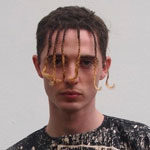About the artist

Joe Clarke
Joe Clarke’s beautiful yet unsettling photograph Nagoya Under Metro depicts the underside of a concrete metro bridge, curtained by trees and illuminated in unnatural hues of green, pink and orange. The scene stirs a deep sense of the uncanny in the viewer; through Clarke’s photographic means and composition, this usually banal and prosaic site is twisted into an alien and startling vision.
In the early 20th century Freud described the uncanny, or in German unheimlich, as rooted in the environment of the domestic and habitual, or heimlich. He defined the uncanny as ‘something which ought to have remained hidden, but which has come to light’. (The Uncanny, 1919). The uncanny, therefore, is akin to a haunting – a citation of something that was at one time established and familiar and which has undergone a process of estrangement, ultimately returning as unrecognisable and shocking. Here, Clarke uses the transformative nature of photography to enact this process of estrangement; he reveals the absurdly accepted architectural norm of burying our towns and cities in visually brutal constructions, albeit in the name of practicality. Clarke acutely brings this to our attention by combining chronologically opposed aesthetic genres: he blends classical compositional tools of symmetry with postmodern lighting that is superficial and fractured, to heighten the feeling of discomfort felt by the viewer.
